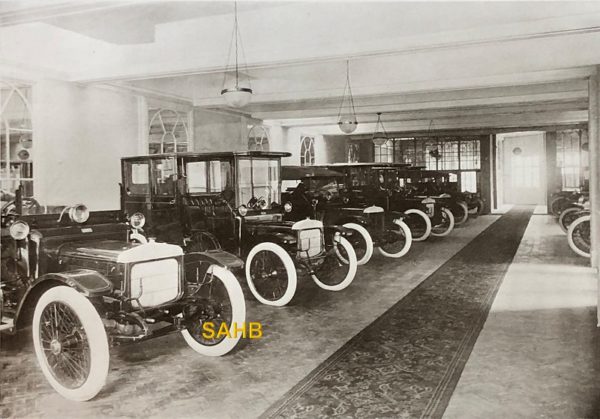
Reading the history of the British Daimler Company, the very last thing that would be expected would be the construction of a prestigious building in central London in 1911 when the company had reached a parlous financial state in 1909. However, the solution to this mystery lies almost certainly in the merger with BSA in 1910.
Britain’s oldest motor car company had seen considerable success between its founding in 1896 and 1908 – but that year saw a complete change in policy: side-valve engines and chain final drive were replaced by sleeve valves and underslung worm drive. For the 1909 season, three 4-cylinder models were offered: a 22HP of 3.7 litres, a 38HP of 6.3 litres and a 48HP 9-litre monster.
At first, sales were encouraging, with 2000 cars sold in 1910 from a workforce of around 4,500, but the cost of the Knight licensing and development work weighed heavily on the firm’s finances, and by 1909 Daimler were on the verge of bankruptcy. They were saved by a merger with BSA on 22 September 1910. BSA made cars and motorcycles as well as small arms, and had double the capital of Daimler and no debt; Daimler owed £51,000. Several BSA directors came onto the Daimler board, including Dudley Docker, whose son Sir Bernard Docker was chairman from 1940 to 1956 and was to have considerable influence on Daimler in the 1950s.
The merger did not immediately go well. By 1913 Daimler’s workforce had reached 5,000, but annual production had declined to 1,000. Despite this, the improved finances following the BSA merger must have allowed some bold moves: not only did the company build Daimler House in Paradise Street, London, as a showroom and repair shop, but a new Coventry factory, known as the Radford Works, was opened in 1912.
Daimler House was modern in many ways. Fireproof construction was used throughout, with floors and roof in reinforced concrete and a façade in Portland stone. To gain maximum window space in Paradise Street for the showroom, cars entered in Swallow Street at the back of the building. Because that was much lower than Paradise Street, a powerful hydraulic lift brought cars up to showroom level. At the lower Swallow Street level were a carriage wash on one side of the lift and a repair shop on the other side.
Our Snapshot shows another modern feature – a complete lack of columns in the showroom. The five upper floors, destined for use as offices, were supported entirely by girders. Daimler House must have been an imposing location: the entrance vestibule was said to have a mosaic floor, panelled walls and an “enriched plaster ceiling”.
Despite the difficulties at that time, Daimler did have two strong advantages: the patronage of royalty and aristocracy not only in Great Britain but also in many countries worldwide, and a commercial division created in 1911 to expand the manufacture of buses, lorries, tractors and railcars that had been going on for some time. During World War I Daimler built 1,000 ambulances and around 4,000 lorries, as well as aero engines and complete aeroplanes, no doubt helping to ensure the company’s survival after the war.
Image courtesy of The Richard Roberts Archive: www.richardrobertsarchive.org.uk







Leave a Comment